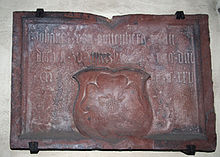Marmelsteiner Hof
The Marmelsteiner Hof (also called Domherrenhof Stadion ), as the Marmelstein Curia, is one of the oldest canon courts in Würzburg . It was named after cathedral capitular Eberhard von Marmelstein in the second half of the 12th century. It was already inhabited then. It was first mentioned in a document in 1251. The building, which was rebuilt after the Second World War, was erected in 1747 by Balthasar Neumann on behalf of cathedral provost Franz Konrad von Stadion und Thannhausen . Even today, the heraldic cartouche on the cornice above the portal (made by Lukas Anton van der Auwera ) is a reminder of the owner. The 1940 copy shows the coat of arms of the Counts of Stadion and Thannhausen. After secularization , the curia became the residence of the provost and dean of the cathedral in 1823.
The Marmelsteiner Hof was also destroyed in the bombing raid on Würzburg on March 16, 1945 . After the reconstruction, the curia was used as an apartment for the bishop, cathedral provost, cathedral dean and other members of the cathedral capital and as an office building. Since 1961 the curia has been used solely as the episcopal ordinariate .
Bishop Paul-Werner Scheele opened the diocesan gallery Marmelsteiner Kabinett in the Marmelsteiner Hof on August 31, 1990 . The gallery was primarily dedicated to the religious art of Franconia and, according to Scheele, should “build bridges between the gospel and culture, between the past and the present, bridges from person to person”.
The Würzburg cathedral treasure, shown as a permanent exhibition in the Marmelsteiner Hof, was transferred to the Kiliansdom in 2015 .
At the entrance to the Marmelsteiner Hof is the coat of arms of the von Guttenberg family , the inscription reads:
"Johannes von Guttenberg thumdechett zu wirtzberg etc. Anno dmni 1525"
Web links
- WürzburgWiki: Marmelsteiner Hof
Individual evidence
- ^ Christoph Pitz: Würzburg Cathedral Treasure .
- ↑ Stefan Kummer : Architecture and fine arts from the beginnings of the Renaissance to the end of the Baroque. In: Ulrich Wagner (Hrsg.): History of the city of Würzburg. 4 volumes; Volume 2: From the Peasants' War in 1525 to the transition to the Kingdom of Bavaria in 1814. Theiss, Stuttgart 2004, ISBN 3-8062-1477-8 , pp. 576–678 and 942–952, here: pp. 655 f. and 949.
- ↑ Klaus Witt City: church and state in the 20th century. In: Ulrich Wagner (Hrsg.): History of the city of Würzburg. 4 volumes, Volume I-III / 2, Theiss, Stuttgart 2001-2007; III / 1–2: From the transition to Bavaria to the 21st century. 2007, ISBN 978-3-8062-1478-9 , pp. 453–478 and 1304 f., Here: pp. 475–478 and 1305: The development at the end of the 20th century - the term of office of Bishop Paul-Werner Scheele ( 1979-2003). P. 477.
- ^ Sybille Grübel: Timeline of the history of the city from 1814-2006. In: Ulrich Wagner (Hrsg.): History of the city of Würzburg. 4 volumes, Volume I-III / 2, Theiss, Stuttgart 2001-2007; III / 1–2: From the transition to Bavaria to the 21st century. Volume 2, 2007, ISBN 978-3-8062-1478-9 , pp. 1225-1247, here: p. 124.
- ^ Paul-Werner Scheele: Church-Art-Culture. Legacy and mission of the Diocese of Würzburg. Speech on the occasion of the opening ceremony of the Marmelstein Cabinet on August 31, 1990 (Archives of the Bishop's House).
- ^ Wolfgang Schneider: Würzburg Cathedral Treasure .
Coordinates: 49 ° 47 '31.9 " N , 9 ° 55' 54.6" E



